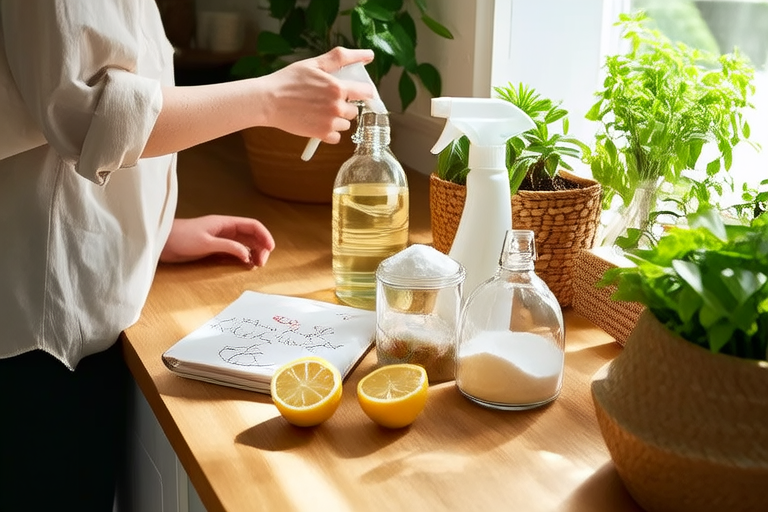DIY Cleaning Solutions: A Guide to Green Maintenance Practices at Home
Introduction
Maintaining a clean and healthy home is essential for both your well-being and the environment. However, traditional cleaning products often contain harsh chemicals that can be harmful to your health and the planet. By opting for DIY cleaning solutions, you not only reduce your exposure to toxic substances but also contribute to sustainable living. This guide will walk you through the basics of creating your own eco-friendly cleaning products, offering practical tips and recipes to keep your home sparkling without compromising on safety.
Understanding the Benefits of Green Cleaning
Why Choose DIY Over Store-Bought Cleaners?
Traditional commercial cleaners are often laden with volatile organic compounds (VOCs), artificial fragrances, and other potentially hazardous ingredients. These chemicals can irritate your skin, eyes, and respiratory system, especially if used frequently or in poorly ventilated areas. Moreover, many of these chemicals end up in our water systems, contributing to environmental pollution.
By making your own cleaning solutions, you have full control over what goes into them. You can use natural, biodegradable ingredients that are gentle on your family and pets while being effective at removing dirt and grime. Additionally, DIY cleaning solutions tend to be more cost-effective in the long run, as most of the ingredients are inexpensive and widely available.
The Environmental Impact of Commercial Cleaners
The production, packaging, and disposal of commercial cleaning products contribute significantly to environmental degradation. Many of these products come in plastic containers that take centuries to decompose. Furthermore, the manufacturing process itself consumes large amounts of energy and water. By switching to DIY cleaning solutions, you can minimize waste and reduce your carbon footprint.
Essential Ingredients for DIY Cleaning Solutions
Common Household Items That Work Wonders
Creating effective yet environmentally friendly cleaning solutions doesn’t require specialized equipment or rare ingredients. Most of what you need can be found right in your kitchen pantry:
- White vinegar: A versatile disinfectant that cuts through grease and removes odors.
- Baking soda: An excellent abrasive agent that helps scrub away tough stains.
- Lemon juice: Contains citric acid, which is great for brightening surfaces and eliminating odors.
- Castile soap: Made from vegetable oils, this gentle soap is perfect for general cleaning tasks.
- Essential oils: Add a pleasant scent while providing additional antibacterial properties.
Mixing and Matching Ingredients for Different Needs
Different surfaces and tasks may require different combinations of ingredients. For instance, a solution of equal parts water and white vinegar works wonders for windows and mirrors, leaving them streak-free. On the other hand, mixing baking soda with a little water creates a paste ideal for scrubbing ovens and stovetops. Adding a few drops of essential oil like lavender or tea tree can enhance the cleaning power and leave behind a refreshing aroma.
Step-by-Step Recipes for Homemade Cleaners
All-Purpose Cleaner
Ingredients:
- 1 cup white vinegar
- 1 cup water
- 1 tablespoon Castile soap
- 10-15 drops of essential oil (optional)
Instructions:
- Combine all ingredients in a spray bottle.
- Shake well before each use.
- Spray onto surfaces and wipe clean with a cloth.
This all-purpose cleaner is safe for use on most household surfaces, including countertops, floors, and walls. It’s particularly effective at cutting through grease and removing stubborn stains.
Glass Cleaner
Ingredients:
- 1 cup white vinegar
- 2 cups water
- 1 tablespoon rubbing alcohol (optional)
- 10-15 drops of lemon essential oil (optional)
Instructions:
- Mix all ingredients in a spray bottle.
- Apply to glass surfaces and wipe with a lint-free cloth for a streak-free shine.
This recipe leaves no streaks and eliminates the need for ammonia-based window cleaners, which can be irritating to the eyes.
Oven Cleaner
Ingredients:
- 1 cup baking soda
- 2 tablespoons liquid dish soap
- Water
Instructions:
- Preheat oven to 200°F (93°C) for 20 minutes.
- Remove oven racks and sprinkle baking soda over the entire surface.
- Pour water over the baking soda until it forms a paste.
- Let sit for 10-15 minutes, then scrub with a sponge dipped in soapy water.
- Rinse with warm water and dry thoroughly.
This method is much safer than using chemical oven cleaners and works just as effectively.
Practical Tips for Implementing Green Cleaning Practices
Creating a Routine
Consistency is key when it comes to maintaining a clean and healthy home. Establishing a regular cleaning schedule ensures that tasks are completed efficiently and prevents buildup of dirt and grime. Consider setting aside specific days for different areas of your home, such as bathrooms on Mondays and kitchens on Wednesdays.
Educating Family Members
Encouraging everyone in your household to participate in green cleaning practices fosters a shared commitment to sustainability. Teach children how to safely use homemade cleaners and involve them in age-appropriate cleaning tasks. This not only promotes teamwork but also instills important life skills.
Storing and Labeling Your Cleaners
Proper storage and labeling of your DIY cleaning solutions are crucial for safety and convenience. Use clear, airtight containers with secure lids to prevent spills and contamination. Clearly label each container with its contents and date of preparation to avoid confusion.
Conclusion
Switching to DIY cleaning solutions is a simple yet impactful way to adopt greener maintenance practices at home. Not only do these solutions promote healthier living by reducing exposure to harmful chemicals, but they also help protect the environment by minimizing waste and conserving resources. By following the steps outlined in this guide, you can create effective, eco-friendly cleaning products tailored to your needs. Start small, experiment with different recipes, and gradually incorporate more sustainable habits into your daily routine. Together, we can make a difference one cleaner at a time!
